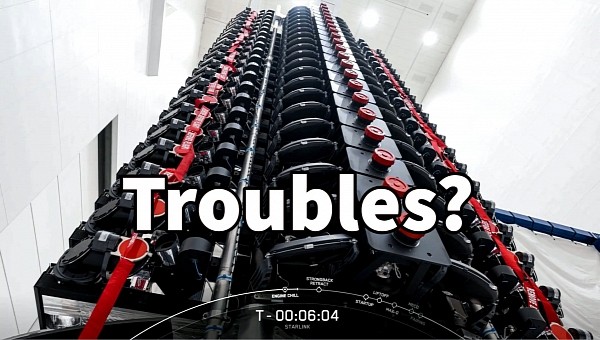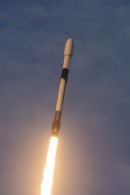SpaceX recently launched its first group of Starlink V2 Mini satellites, touting improved capabilities, with four times the data capacity of the previous generation. Soon, astronomers noticed that the satellites started to descend rather than rise. On Wednesday, Elon Musk confirmed that SpaceX is experiencing "some issues."
On February 27, SpaceX successfully launched into space its first batch of the Starlink V2 Mini satellites. The "Group 6-2" consisted of 21 second-generation satellites essential for SpaceX's plans to offer satellite-to-phone services in the coming years. The Mini moniker means they are smaller than the full-blown Starlink V2 satellites that SpaceX intends to launch when the Starship rocket is ready for commercial service.
The Starlink V2 Mini satellites deployed at an altitude of about 370 km (230 miles) and were expected to rise above the International Space Station, which has an orbit between 415 and 420 kilometers (around 260 miles) high. The satellites halted their orbit raising soon after the launch, and on March 15, their orbital altitude started to decrease, in two cases abruptly. All 21 satellites remain in orbit for now, but the unusual behavior has prompted speculations about possible problems.
On Wednesday, SpaceX CEO Elon Musk confirmed "some issues" with the Starlink V2 Mini satellites launched on February 27. Musk said there are many new technologies in the new satellites, which were expected to have some teething issues. "Some sats will be deorbited, others will be tested thoroughly before raising altitude above Space Station," said Musk.
Among the new technologies Musk mentioned they could pose problems are the new higher-performance Hall effect thrusters. Instead of krypton, they use argon as a propellant to reduce costs. The new thrusters should provide 2.4 times the thrust generated by krypton thrusters. The second-generation satellites also feature improved phase-array antennas and E-band frequencies for backhaul, offering enhanced data bandwidth and capabilities.
While SpaceX hasn't released V2 Mini specifications, it notified the FCC about an "F9-2" design as part of its second-generation constellation. Based on that, the Starlink V2 Mini satellites weigh about 800 kg (1,800 lb) and are powered by a pair of solar arrays 12.8 meters (42 feet) long. The first generation Starlink sats weigh three times less and use a single solar array 8 meters (26 feet) long. The Starlink V2 will be much heavier, at about 2,000 kg (4,400 lb), hence the need for Starship to launch them.
The FCC has partially authorized SpaceX's second-generation (Gen2) Starlink constellation. According to the license, SpaceX can deploy 7,500 of its proposed 30,000 satellites into orbits ranging from 525 to 535 kilometers (326-332 miles). According to SpaceNews, SpaceX has launched four sets of "Group 5" satellites into the authorized Gen2 orbits, although these appeared identical to earlier Starlink satellites. Another Group 5 launch is scheduled for March 24 from Cape Canaveral Space Force Station in Florida. The second set of V2 Mini, or Group 6-2, should launch on March 30, but recent issues might delay the launch.
The Starlink V2 Mini satellites deployed at an altitude of about 370 km (230 miles) and were expected to rise above the International Space Station, which has an orbit between 415 and 420 kilometers (around 260 miles) high. The satellites halted their orbit raising soon after the launch, and on March 15, their orbital altitude started to decrease, in two cases abruptly. All 21 satellites remain in orbit for now, but the unusual behavior has prompted speculations about possible problems.
On Wednesday, SpaceX CEO Elon Musk confirmed "some issues" with the Starlink V2 Mini satellites launched on February 27. Musk said there are many new technologies in the new satellites, which were expected to have some teething issues. "Some sats will be deorbited, others will be tested thoroughly before raising altitude above Space Station," said Musk.
Among the new technologies Musk mentioned they could pose problems are the new higher-performance Hall effect thrusters. Instead of krypton, they use argon as a propellant to reduce costs. The new thrusters should provide 2.4 times the thrust generated by krypton thrusters. The second-generation satellites also feature improved phase-array antennas and E-band frequencies for backhaul, offering enhanced data bandwidth and capabilities.
While SpaceX hasn't released V2 Mini specifications, it notified the FCC about an "F9-2" design as part of its second-generation constellation. Based on that, the Starlink V2 Mini satellites weigh about 800 kg (1,800 lb) and are powered by a pair of solar arrays 12.8 meters (42 feet) long. The first generation Starlink sats weigh three times less and use a single solar array 8 meters (26 feet) long. The Starlink V2 will be much heavier, at about 2,000 kg (4,400 lb), hence the need for Starship to launch them.
The FCC has partially authorized SpaceX's second-generation (Gen2) Starlink constellation. According to the license, SpaceX can deploy 7,500 of its proposed 30,000 satellites into orbits ranging from 525 to 535 kilometers (326-332 miles). According to SpaceNews, SpaceX has launched four sets of "Group 5" satellites into the authorized Gen2 orbits, although these appeared identical to earlier Starlink satellites. Another Group 5 launch is scheduled for March 24 from Cape Canaveral Space Force Station in Florida. The second set of V2 Mini, or Group 6-2, should launch on March 30, but recent issues might delay the launch.
Lot of new technology in Starlink V2, so we’re experiencing some issues, as expected.
— Elon Musk (@elonmusk) March 22, 2023
Some sats will be deorbited, others will be tested thoroughly before raising altitude above Space Station.








